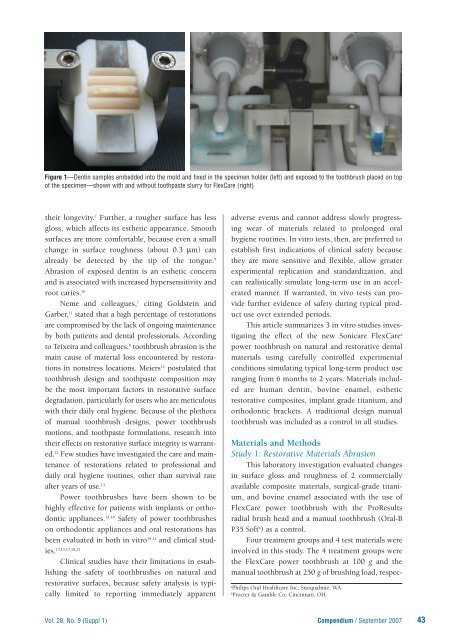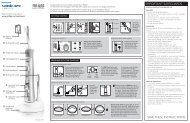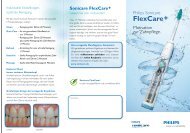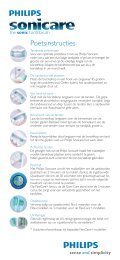Philips Sonicare FlexCare - Sonicare.com - Sonicare
Philips Sonicare FlexCare - Sonicare.com - Sonicare
Philips Sonicare FlexCare - Sonicare.com - Sonicare
You also want an ePaper? Increase the reach of your titles
YUMPU automatically turns print PDFs into web optimized ePapers that Google loves.
Figure 1—Dentin samples embedded into the mold and fixed in the specimen holder (left) and exposed to the toothbrush placed on top<br />
of the specimen—shown with and without toothpaste slurry for <strong>FlexCare</strong> (right)<br />
their longevity. 7 Further, a rougher surface has less<br />
gloss, which affects its esthetic appearance. Smooth<br />
surfaces are more <strong>com</strong>fortable, because even a small<br />
change in surface roughness (about 0.3 µm) can<br />
already be detected by the tip of the tongue. 9<br />
Abrasion of exposed dentin is an esthetic concern<br />
and is associated with increased hypersensitivity and<br />
root caries. 10<br />
Neme and colleagues, 7 citing Goldstein and<br />
Garber, 11 stated that a high percentage of restorations<br />
are <strong>com</strong>promised by the lack of ongoing maintenance<br />
by both patients and dental professionals. According<br />
to Teixeira and colleagues, 8 toothbrush abrasion is the<br />
main cause of material loss encountered by restorations<br />
in nonstress locations. Meiers 12 postulated that<br />
toothbrush design and toothpaste <strong>com</strong>position may<br />
be the most important factors in restorative surface<br />
degradation, particularly for users who are meticulous<br />
with their daily oral hygiene. Because of the plethora<br />
of manual toothbrush designs, power toothbrush<br />
motions, and toothpaste formulations, research into<br />
their effects on restorative surface integrity is warranted.<br />
12 Few studies have investigated the care and maintenance<br />
of restorations related to professional and<br />
daily oral hygiene routines, other than survival rate<br />
after years of use. 13<br />
Power toothbrushes have been shown to be<br />
highly effective for patients with implants or orthodontic<br />
appliances. 14-18 Safety of power toothbrushes<br />
on orthodontic appliances and oral restorations has<br />
been evaluated in both in vitro 19-22 and clinical studies.<br />
13,15,17,18,23<br />
Clinical studies have their limitations in establishing<br />
the safety of toothbrushes on natural and<br />
restorative surfaces, because safety analysis is typically<br />
limited to reporting immediately apparent<br />
adverse events and cannot address slowly progressing<br />
wear of materials related to prolonged oral<br />
hygiene routines. In vitro tests, then, are preferred to<br />
establish first indications of clinical safety because<br />
they are more sensitive and flexible, allow greater<br />
experimental replication and standardization, and<br />
can realistically simulate long-term use in an accelerated<br />
manner. If warranted, in vivo tests can provide<br />
further evidence of safety during typical product<br />
use over extended periods.<br />
This article summarizes 3 in vitro studies investigating<br />
the effect of the new <strong>Sonicare</strong> <strong>FlexCare</strong> a<br />
power toothbrush on natural and restorative dental<br />
materials using carefully controlled experimental<br />
conditions simulating typical long-term product use<br />
ranging from 6 months to 2 years. Materials included<br />
are human dentin, bovine enamel, esthetic<br />
restorative <strong>com</strong>posites, implant grade titanium, and<br />
orthodontic brackets. A traditional design manual<br />
toothbrush was included as a control in all studies.<br />
Materials and Methods<br />
Study 1: Restorative Materials Abrasion<br />
This laboratory investigation evaluated changes<br />
in surface gloss and roughness of 2 <strong>com</strong>mercially<br />
available <strong>com</strong>posite materials, surgical-grade titanium,<br />
and bovine enamel associated with the use of<br />
<strong>FlexCare</strong> power toothbrush with the ProResults<br />
radial brush head and a manual toothbrush (Oral-B<br />
P35 Soft b ) as a control.<br />
Four treatment groups and 4 test materials were<br />
involved in this study. The 4 treatment groups were<br />
the <strong>FlexCare</strong> power toothbrush at 100 g and the<br />
manual toothbrush at 250 g of brushing load, respec-<br />
a<br />
<strong>Philips</strong> Oral Healthcare Inc; Snoqualmie, WA.<br />
b<br />
Procter & Gamble Co; Cincinnati, OH.<br />
Vol. 28, No. 9 (Suppl 1) Compendium / September 2007<br />
43










